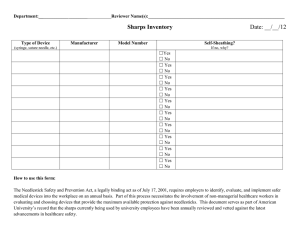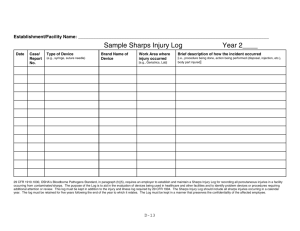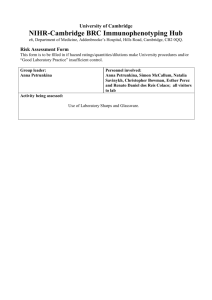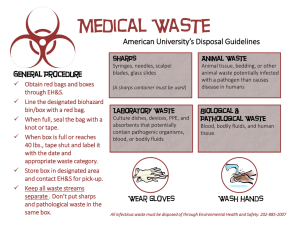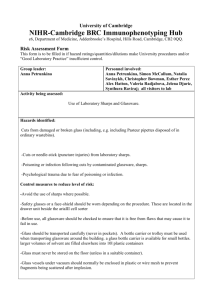1- Lab Safety and rules
advertisement
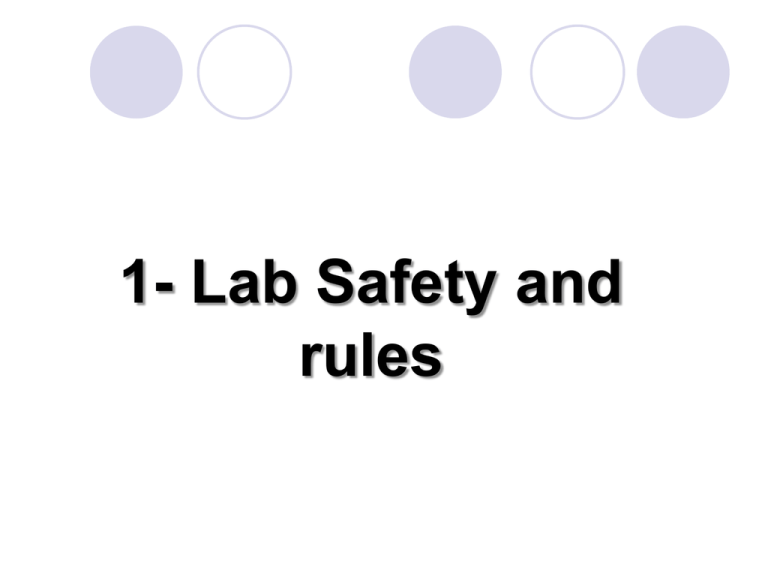
1- Lab Safety and rules Why is Lab Safety Important? Lab safety is a major aspect of every lab based science class. Lab safety rules and symbols are needed so that students do not injure themselves or their classmates. Lab Safety Rules 1. Always follow the teacher’s directions and only do lab work when a teacher is present. 2. Conduct yourself in a responsible manner at all times. No Horseplay! 3. Do not touch any equipment, chemicals, or other materials until told to do so. 4. Do not eat food, drink beverages, or chew gum in the lab. Do not use lab glassware as food or beverage containers 5. Report ALL accidents to your teacher immediately, even if you think it is minor. Clothing Wear: • Goggles/safety glasses • Closed-toed shoes • Clothing made of natural based fiber such as cotton • Tie back long hair Do NOT Wear: • Sandals • Jewelry • Loose or Baggy clothing Lab Safety Equipment Safety Shower Eye Wash Safety Goggles Lab Safety Equipment Fire Extinguisher Fire Blanket Fume Hood Lab Safety Symbols Found in your textbook Glassware Electrical Heat Animal Eye and Face Chemical Sharps Fire Other Chemical Hazards and Symbols Flammable Irritant Explosive Corrosive Toxic/Poison Environmenta l Chemical Hazard Symbols and Definitions Flammable – Any substance that will burn if exposed to an open flame. Explosive – A substance that explode if exposed to heat or flame. may Chemical Hazard Symbols and Definitions Toxic/Poison – A substance that can lead to death if inhaled, ingested, or absorbed by the skin. Corrosive – A substance that can destroy or burn living tissue and can eat away at other materials. Chemical Hazard Symbols and Definitions Irritant - A substance that causes inflammation upon contact with skin or mucous membranes. Environmental - Substances that are harmful to the environment. They must be disposed of properly, not washed down the drain. Accidents and Injuries Report ALL accidents and injuries to your teacher immediately!!! Be aware of safety hazards associated with each chemical you use. Eye accident – Wash the eye with copious amounts of water for at least 15 min. Fire Burns – Stop, Drop, and be covered with a fire blanket or soaked with water. Do not remove clothing stuck to victim. Get medical attention immediately. Waste Disposal First ask your teacher where/how to dispose of waste. Never pour anything down the drain unless you are told to do so. A waste bottle will be supplied for substance that cannot go down the drain Reasons for proper waste disposal Hazardous chemicals down the drain can lead to pollution of ground water, lakes, rivers, etc. Plants and animals will die if they are exposed to hazardous chemical waste. Serious health problems will become present in people if hazardous waste finds its way into drinking water. Laboratory Rules No eating or drinking in labs Do not enter stockroom or back halls Clean up after yourself Laboratory Etiquette Clean your personal workspace after use Wipe down benches with disinfectant before and after use. Ensure that no trash is left behind No trash in the sinks Push in chairs Place lab items back on carts and trays Learning Center & Open Labs The LC and open labs are a bonus, not a right, your flexibility is appreciated Hours are posted on LC and lab doors Hours are subject to change without notice Some study items may not be available a day or two before an exam Don’t wait until the last day to study Laboratory Safety 1. Laboratory Hygiene 2. Sharps Safety 3. Safety Equipment 4. Fire Safety 5. Chemical Safety 1. Laboratory Hygiene Scrub hands thoroughly when finished Avoid cross contamination • Do not touch self, faucets, doorknobs, notebooks, pens etc. with gloves on. • Keep a pen or two in your drawer for lab use only Clean and disinfect your workspace 2. Sharps Safety Sharps include • • • • Razor and scalpel blades Needles and pins Microscope cover slips Broken glass Place sharps in sharps boxes Broken Glass into glass box (ask for help) NO SHARPS OR GLASS IN THE TRASH 3. Safety Equipment Do not hesitate to use safety equipment. It is for student use as well as instructor use. Shower and eyewash (15 min. soak) First aid kit Fire extinguisher, Fire blanket, Alarm pulls 4. Fire Safety Never leave flames unattended Do not use flammables near ignition sources Fire Extinguishers • Pull ring, aim at fire’s base, squeeze handle, sweep back and forth (evacuate if >1m3) Fire Blanket Fire alarm pulls 5. Chemical Safety Wear gloves and glasses where appropriate Follow instructor’s directions Dispose of waste properly-Do Not pour down the drain Laboratory Safety Rules 1. Many things happen in the lab, and you can never be sure how your area has been used, or whether it was properly cleaned up. Because of this, and possible contamination from the animals, you should not bring food or drink into the lab with you! Also, don't put anything that's come in contact with the lab table-pens, pencils, fingers, etc. - into your mouth or eyes. Laboratory Safety Rules 2. Be on time! There are several ways being late can hurt your grade directly, but there are safety considerations as well Lab instructions, including safety items, are gone over at the beginning of the labs. Laboratory Safety Rules 3. It's always a good idea to look your lab exercise over ahead of time, and make notes of the modifications and warnings given at the beginning of the class. Laboratory Safety Rules 4. Any time you're not sure, ask!! Laboratory Safety Rules 5. Wash your hands before and especially after working in the lab. Laboratory Safety Rules 6. There are drawers and coat hooks available keep all unnecessary objects out of your and other people's way. Laboratory Safety Rules 7. Although labs rarely involve dangerous materials, some can have lasting effects on clothing, so you might want to bring a protective cover-up. With some procedures, protective eye coverings will be required. If you have long hair or dangling jewelry, keep them out of your working materials. Laboratory Safety Rules 8. Clean up your stuff! Your area should look at the end of your lab like it did when you started. When in groups, everyone is responsible for cleanup. Points may be lost if this is not done. Laboratory Safety Rules 9. When working with chemicals or cultures, make sure you do not mix things together in the source glassware - that includes droppers and mixing rods. It is not always safe to mix tap water into materials by washing them, either. Laboratory Safety Rules 10. Dispose of all waste materials properly. The wastebasket is near the door. Broken glass does not go into the wastebasket there's a special box for it next door in the prep room. Notify the instructor any time something gets broken or if you're injured, even mildly. Laboratory Safety Rules 11. Try to always stay alert while you're in the lab. Know where the emergency equipment - first aid kit, fire extinguisher, eyewash fountain, etc are (most are on the front wall or just across the hall). Know the appropriate route out of the building during an emergency.
